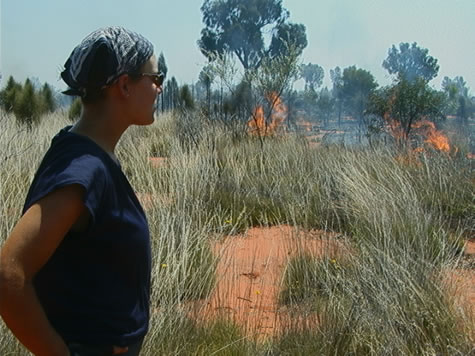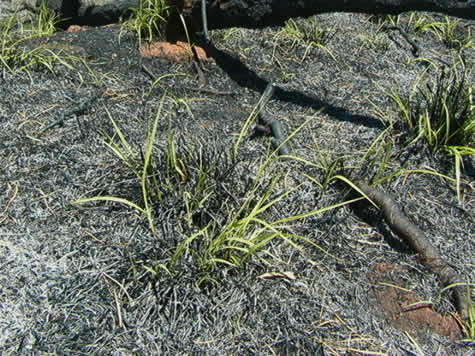2001 September 17, Monday. North of Ace Bore.
Today we saw first hand the extent to which fire has become a natural part of this landscape, and how little impact small and regular fires can have on the dominant ecosystem here. Less than one minute after the fire burnt across the ground where we were watching, I walked into the burnt area beyond the fire’s front without danger. Git picked up the ash of a spinifex clump we had just been watching burn, and let the soft grey-black fibre dissolve through her fingers, and float away with the breeze.

Small regular fires benefit the ecosystem simply because they prevent raging wildfires, which no small creature can endure, as they have to travel too far to find food and shelter from predators. Dingoes, and feral predatory animals, such as cats and foxes, are deterred by the spiky form of spinifex. This makes the grasslands an excellent home for lizards, and an important tool for the protection of endangered species such as the great desert skink.
Over forty thousand years ago, aborigines came to Australia and began burning the country to find food and to make crossing the land easier. Many species would have found this difficult to live with, and for some it would have meant extinction. Since that time, both plants and animals have adapted to regular burning, and a new balance was formed. It was not until last century that a drastic change occurred again in the way the land was being managed, and lack of burning caused problems with uncontrollably large fires, and introduced species like buffel grass, which spread hot fires rapidly.
Many aboriginal people moved into settlements in the early 1900's, and today, without the guidance of people who have inhabited the country for generations, there is little method to the fires that occur in out of the way desert landscapes, such as the ones we have seen today.
The World Wildlife Fund and the Threatened Species Network now work with central Australian indigenous communities to try to reinstate patch burning – the regular burning of small areas of bush to protect biodiversity. They are taught the importance of their traditional landcare, and of protecting the once-common animals which are disappearing from neglected and abused bush areas.
Have you ever seen ‘burning off’ on roadsides or in agricultural land? If you have, you might also have noticed the lush green of the first new growth after the burning. Think about the benefits of supporting young growth in such a harsh environment, and some of the animals which would gather to feed on the new growth which follows fire.
bel
